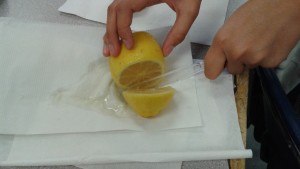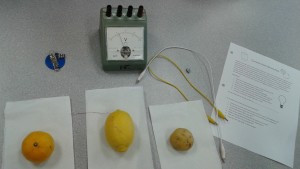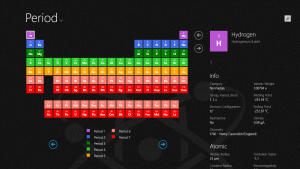Voici notre tableau de planification pour notre Balado.
Category Archives: Grade 9
Currents from the Kitchen
In this experiment, we used a potato, an orange and a lemon to try to light a led light bulb.
- To produce electron flow, a complete will light the bulb.
- To find out if electrons are flowing, you could use a volt meter to measure it.
- Our light bulb had too high of a voltage, and our fruits/vegetables didn’t produce enough voltage.
- To improve our results, we could use bigger vegetables/fruits or light bulbs with lower voltage levels.
- In this experiment, the transition metals and the crocodile clips cause the electrons to flow.
- If you were camping, or there was power outage or any situation where you were without electricity, you could use these foods are sources of electricity.
- No, because this was discovered a while ago. There are not fruits/vegetables big enough to power a 60 watt light bulb let alone a city or a computer.


Electricity Conductors
My classmate and I will be using a citric fruit (lemon or orange) for this experiment because we believe that due to the high levels of acidity in the fruit will result in a good conduction of electricity.
PoCo-Opolis 500
https://www.youtube.com/watch?v=PbzAwlRtEwo
Electricity Mind Map
Solution Fluency
Reviewing the app: Chemistry Lab: For Windows
How will this app help me in science?
This app takes you through the periodic table. It labels and gives a large amount of information about the element as well as various sources online.
What grade would find this app the most useful?
Anywhere from grade 8-12. Around the age from where you would use the periodic table.
How does the app work?
When you open the app, a periodic table will appear. To view a certain element, all you need to do is click on it. Scroll through the information and at the bottom there is a key that helps you identify the family. You can also browse through the families by themselves as opposed to viewing the rest of the elements at the same time.
Why should I get this app?
This app is very handy for study or learning about elements. The information is very useful and accessible. As opposed to doing research on each element, the information is all put in one simple place. It also organizes the elements by over 20 categories. Ex: Boiling point, period, family etc.
When would I use this app?
Most likely in chemistry. For studying, learning or researching.
How easy is the app to understand?
It is quite simple. You have a periodic table are large buttons indicating where to click to change something.
How does the app help you learn?
It gives you plenty of knowledge about the periodic table and shows you how the elements are organized. It gives you facts you would have had to spend time on the internet researching at your fingertips.
Here is a screenshot of the app.
Indium Facts
click here Indium Facts
Here is my video talking about the element Indium.
Science: 1.2
In section 1.2, we learned about matter, mass, volume and states of matter as well. Matter can be anything that has a mass and volume. As long as it has physical properties, it will be matter. Mass is the amount of matter within the substance or object.
But what is a change of state? A change of state is when a substance will change from one form to another. In total, there are 6 changes of state. Sublimation, deposition, melting, solidification, evaporation and condensation. An example would be when a liquid turns into a gas. (Evaporation) the state of solids have definite shapes and volumes. Liquids have a definite volume, but the shape is formed by the container that it is in. The changes of state can be tricky to remember. Some are a bit simpler such as melting (Solid to liquid). If you think of examples for the changes they become a bit easier. When ice cream changes from its liquid form to solid form, it is called solidification. When puddles on the sidewalk disappear it is called evaporation. The toughest are most likely sublimation and deposition. The air deposes itself into a solid form (deposition) Solids become “sublime” when they float up and away into gas (sublimation). Finding the root of the word can make it easier.
The kinetic molecular theory is used to explain what changes occur to matter when the kinetic energy of particles change. This theory aids in describing especially what happens during changes of state. Kinetic energy has higher levels in hot objects. Cold objects have low levels of kinetic energy. The particles in cold objects merely move back and forth. Whereas the particles in hot objects move much faster.
In the bag of change lab, I learned about the chemical reactions that can occur when substances are mixed together. The three substances quickly became hot after being mixed together, showing that they now had higher levels of kinetic energy then when they were separated.
Digital Footprints
My powerpoint on digital footprints:
Digital Footprints click on Digital footprints to see powerpoint.

